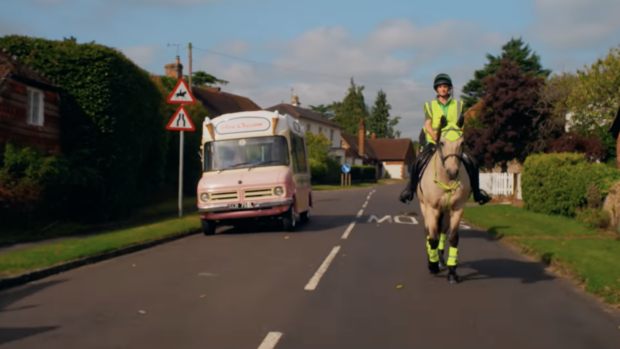By Charles Runcie
Margaret Runcie, a leading figure in the UK equestrian world died on 23 December, aged 97.
Margaret Mary Power was born in Hertfordshire. Her interest in ponies started aged three, riding the family donkey, then she joined the Enfield Chace branch of the Pony Club to compete in showing, showjumping and cross-country. Leaving school in 1941, she spent the next two years keeping the Enfield Chace Hunt going in wartime, whipping-in and exercising hounds.
After wartime service as a petty officer in the Wrens, she studied dairy animal science at Reading University. In 1950, she joined the Ministry of Agriculture as a milk tester working mainly in Leicestershire’s Belvoir Valley, which was handy for the show circuit and hunting.
In 1953, Margaret won a scholarship to study at the prestigious University of Cornell, US. She initially turned down the invitation, reasoning “I’ve a super hunter who’ll win all the big shows this summer,” but was persuaded by her boss in the end. Among the others on the Queen Mary crossing was her future husband, Ken.
After marriage and moving to Scotland, the arrival of a family in 1958 prompted a switch from hunters. She bought Elizabeth Arden, a pony with the qualities Margaret wanted in a foundation broodmare for her British riding pony stud. This was the Rosslyn Stud, and the start of 40 years of in-hand success. An early win was the supreme championship at the 1960 Royal Highland Show, the presentation made by The Queen and Duke of Edinburgh, and the first of 18 gold medals won there by Elizabeth Arden and her offspring.
Her skills in breeding were clear-cut. Sticking to one family and not following fashion, she was dedicated to breeding ponies of the highest quality, movement and temperament. They had to have clean lines, a good shoulder and be well behaved to suit a life around children. Two of Elizabeth Arden’s influential progeny were Rosslyn Personality and Rosslyn Sweet Talk. Both had wonderful limbs, excellent temperaments and bred fine foals.
Margaret had a tremendous work ethic.
“We’d be at a show all day, get home knackered, yet she was off round the fields to check on the yearlings,” remembers one of many students she taught for stud assistant exams. “She was always around the yard and if we had to get up early to prepare for a show, she would get up too.”
As well as success in the show ring, she became influential outside it. In 1961, she helped set up the Scottish Committee of the National Pony Society (NPS) to promote better standards and education among native pony owners in Scotland.
With her as secretary for 33 years, they worked tirelessly, persuading agricultural shows to put on more native breed classes, setting up a transport pool to share costs, putting on demonstrations to educate people, even coordinating a Scotland-wide dried milk and colostrum scheme for orphan foals. The telephone was never quiet, with people ringing up for help and advice on equine management, advice freely and generously given.
Judging was a natural progression for her, though never planned. Her complete honesty and fairness, with an eye for good conformation, ensured she was in demand. With her size, she was able to ride smaller native breeds. She was a popular figure especially at Irish shows, one of few judges happy to travel from Britain in the 1970s when others were put off by the Troubles.
Already a council member of the main body, Margaret became president of the NPS during its centenary year, 1993. At the annual show that year, she escorted the society’s patron Princess Margaret around, explaining what was happening. She was awarded the NPS Medal of Honour, then in 1995 the prestigious Sir William Young Award from the Royal Highland Agricultural Society.
The citation said: “Her success is in large part due to her attention to detail in all aspects of equine management. However, those in the horse world agree that she has that intangible asset – flair – which separates her from her peers.” She was the first equestrian personality and first woman to be awarded it.
By the 1990s, the fourth generation of Elizabeth Arden’s offspring was winning, particularly Rosslyn Sweet Repose. She had consecutive Highland championships from 1994–7, including a coveted Queen’s Cup in 1996. She qualified for the in-hand championship at Horse of the Year Show five times, winning in 2001 for David Ross. Many consider Sweet Repose the finest pony Margaret ever bred.
In 1997, Margaret decided to retire, and the stud’s dispersal allowed more time to judge, with trips to the US, South Africa, Australia and New Zealand, plus years of continued involvement in many aspects of the equestrian world.
Current NPS president Caroline Nelson, who knew Margaret for over 50 years, said: “To us in the pony world, Margaret was an astute, successful breeder, judge and avid supporter of the British riding pony. Her dedication continued long after the years of breeding, regularly attending shows and assisting with sponsorship. She will be sorely missed by her many friends, and by those who have Rosslyn blood in their studs.”
Her husband Ken predeceased her, in 2011. She is survived by sons Charles and Ian and three grandchildren.
Horse & Hound magazine, out every Thursday, is packed with all the latest news and reports, as well as interviews, specials, nostalgia, vet and training advice. Find how you can enjoy the magazine delivered to your door every week, plus options to upgrade your subscription to access our online service that brings you breaking news and reports as well as other benefits.





